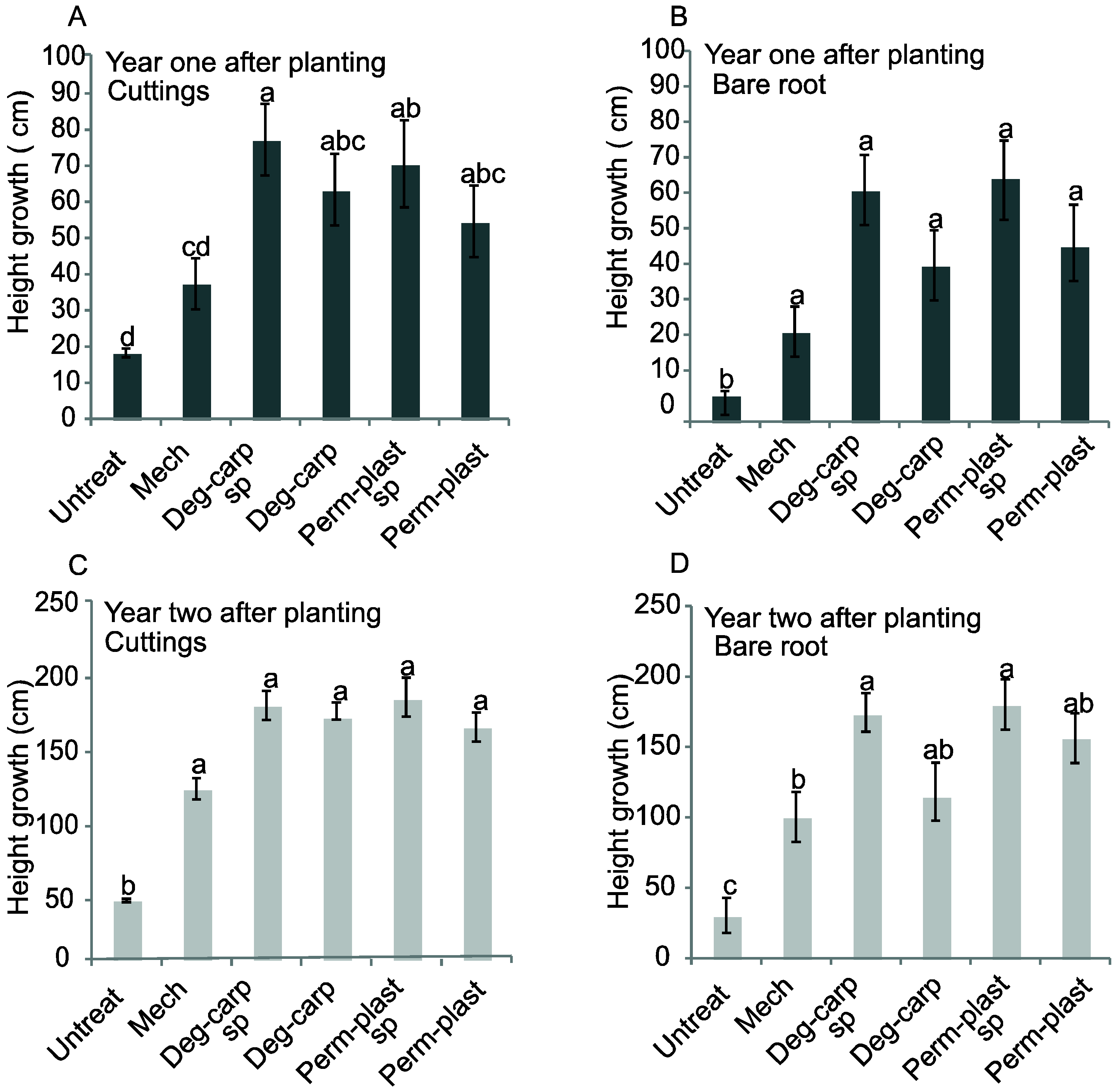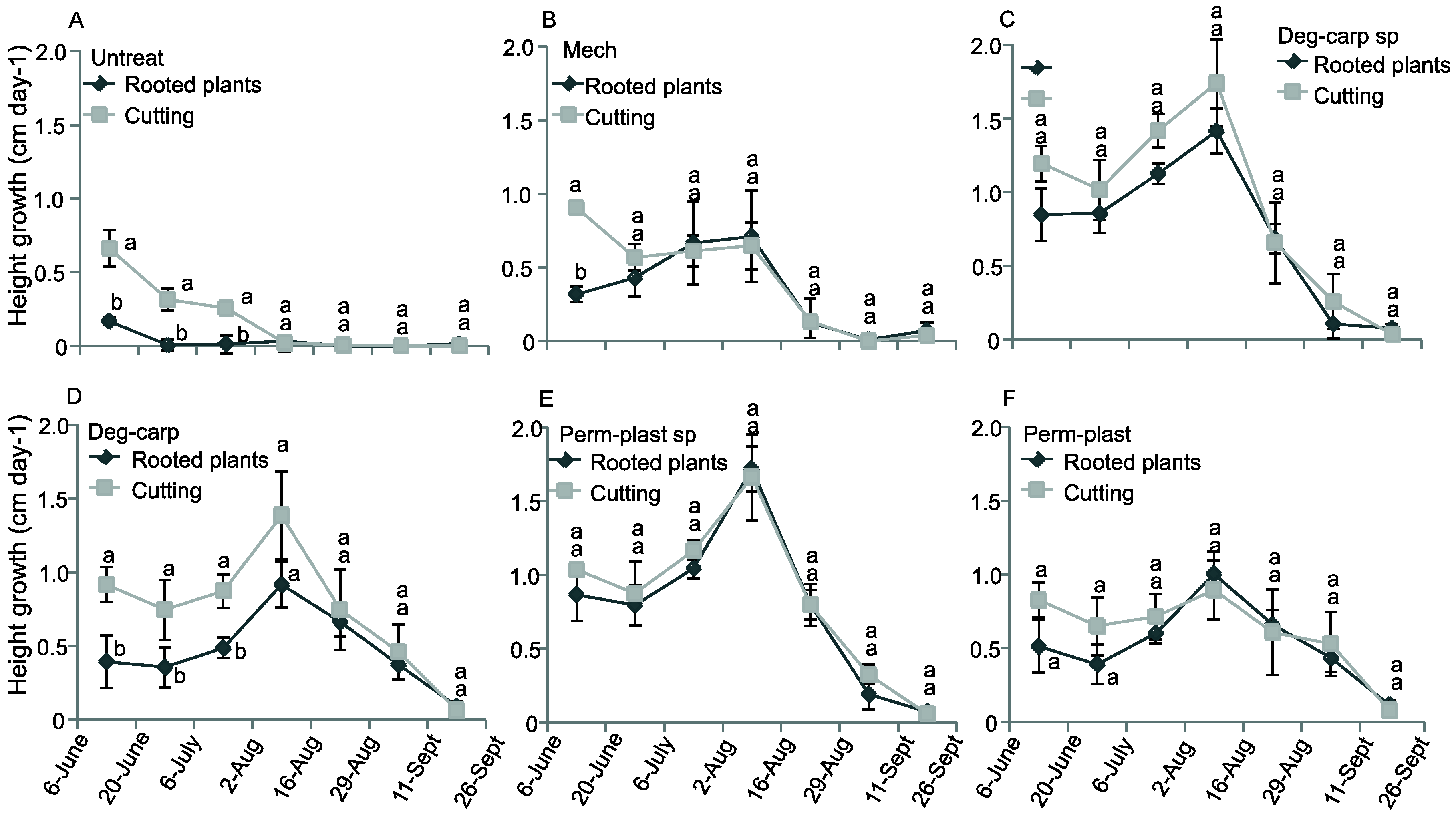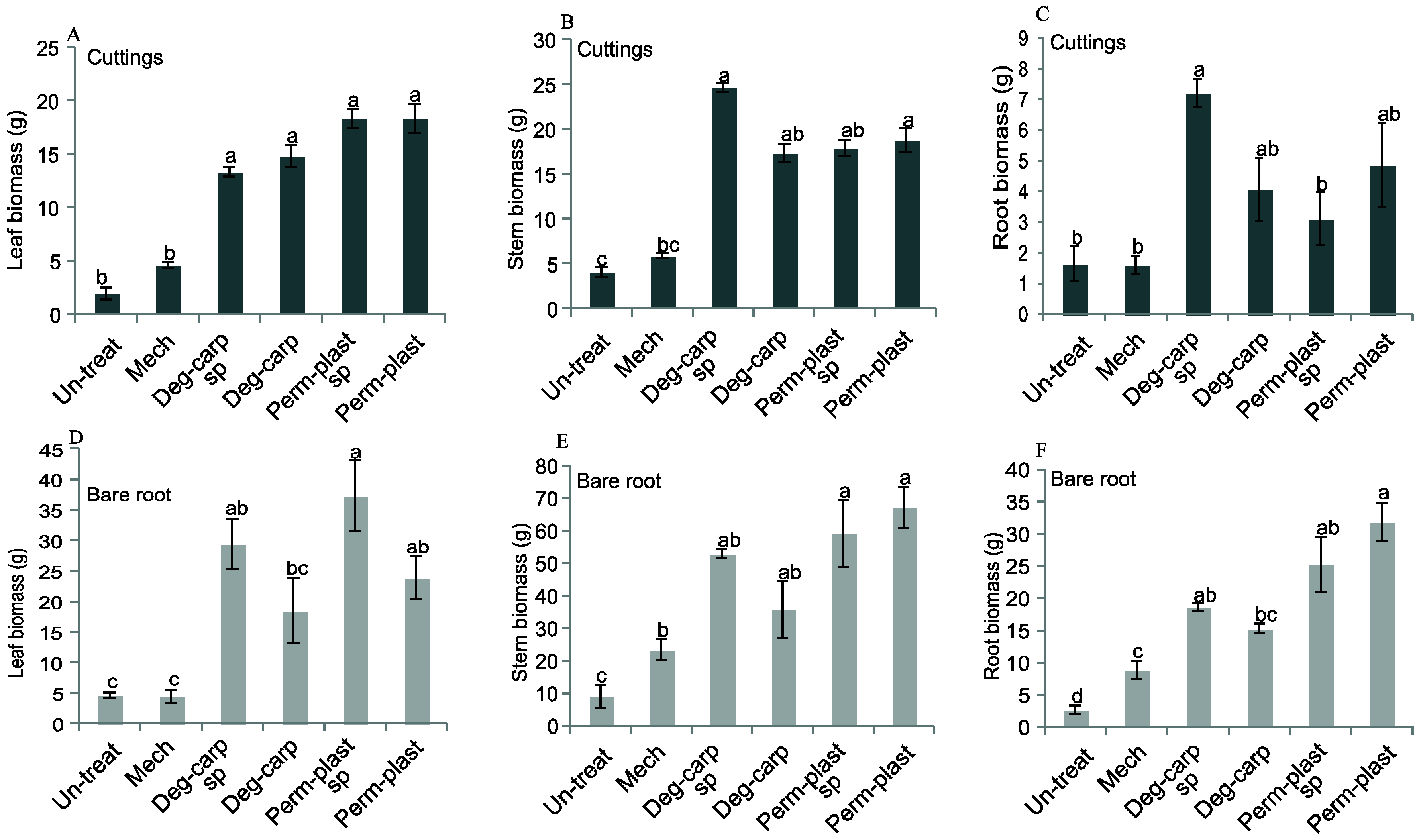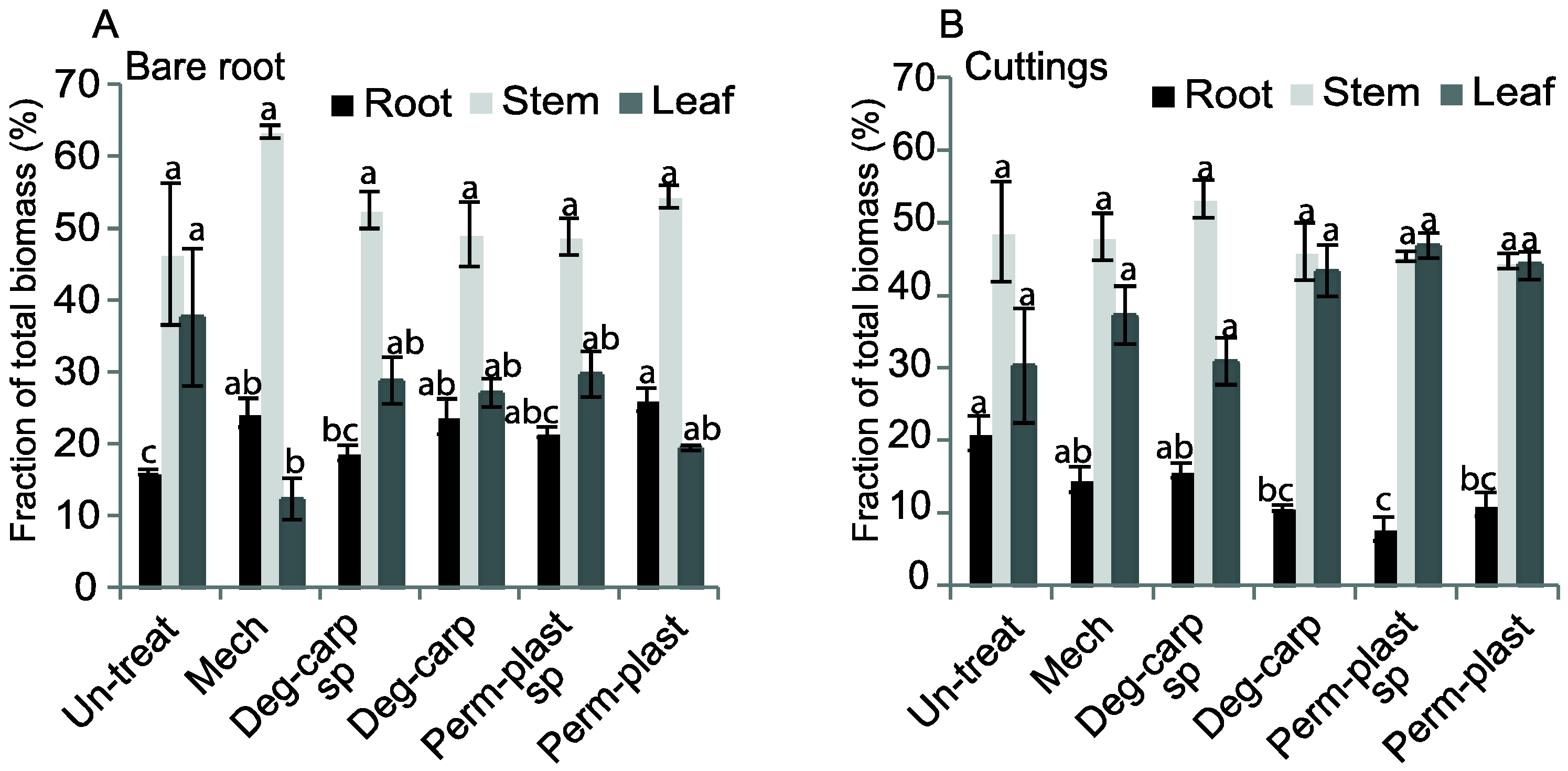Exploration of Optimal Agricultural Practices and Seedling Types for Establishing Poplar Plantations
Abstract
:1. Introduction
2. Materials and Methods
2.1. The Experimental Site and Vegetation Data
2.2. Experimental Design, Vegetation Control Method, and Plant Material
2.3. Height Measurements and Collection of Biomass
2.4. Statistical Analysis
3. Results
3.1. Height Growth and Seedling Mortality

3.2. Growth Rates in the Early Phase of Establishment

3.3. Biomass Production

3.4. Biomass Allocation

4. Discussion
5. Conclusions
Acknowledgments
Author Contributions
Conflicts of Interest
References
- Ma, Q.; Lebedys, A. Poplars and Willows, Trees for Society and the Environment; Isebrands, J.G., Richardson, J., Eds.; CABI: Oxfordshire, UK, 2014; pp. 573–574. [Google Scholar]
- National Research Council of Canada Research Press. Poplar Culture in North America; Dickmann, D.I., Isebrands, J.G., Eckenwalder, J.E., Richardson, J., Eds.; National Research Council of Canada Research Press: Ottawa, Canada, 2001.
- Christersson, L. Poplar plantations for paper and energy in the south of Sweden. Biomass Bioenergy 2008, 32, 997–1000. [Google Scholar] [CrossRef]
- Christersson, L. Wood production potential in poplar plantations in Sweden. Biomass Bioenergy 2010, 34, 1289–1299. [Google Scholar] [CrossRef]
- Tullus, A.; Rytter, L.; Tullus, T.; Weih, M.; Tullus, H. Short-rotation forestry with hybrid aspen (Populus tremula L. × P. tremuloides Michx.) in northern Europe. Scand. J. For. Res. 2011, 27, 10–29. [Google Scholar] [CrossRef]
- Coll, L.M.; Delagrange, C.; Berninger, S.F. Growth, allocation and leaf gas exchanges of hybrid poplar plants in their establishment phase on previously forested sites: Effect of different vegetation management techniques. Ann. For. Sci. 2007, 64, 275–285. [Google Scholar] [CrossRef] [Green Version]
- Otto, S.; Loddo, D.; Zanin, G. Weed-poplar competition dynamics and yield loss in Italian short-rotation forestry. Weed Res. 2010, 50, 153–162. [Google Scholar] [CrossRef]
- Wagner, R.G.; Mohammed, G.H.; Noland, T.L. Critical period of interspecific competition for northern conifers associated with herbaceous vegetation. Can. J. For. Res. 1999, 29, 890–897. [Google Scholar] [CrossRef]
- Wagner, R.G.; Noland, T.L.; Mohammed, G.H. Timing and duration of herbaceous vegetation control around four northern coniferous species. For. Sci. 1996, 26, 39–52. [Google Scholar]
- Hansen, E.A.; Netzer, D.; Toldsted, D.N. Guideline for Establishing Poplar Plantations in the North-West U.S.; Deptartment of Agriculture, Forest Service, North Central Forest Experiment Station: St. Paul, MN, USA, 1993. [Google Scholar]
- Green, D.S.; Kruger, E.L.; Stanosz, G.R. Effects of polyethylene mulch in a short-rotation, poplar plantation vary with weed-control strategies, site quality and clone. For. Ecol. Manag. 2003, 173, 251–260. [Google Scholar] [CrossRef]
- DeBell, D.S.; Harrington, C.A. Productivity of Populus in monoclonal and polyclonal blocks at three spacings. Can. J. For. Res. 1997, 27, 978–985. [Google Scholar] [CrossRef]
- Hartmann, H.T.; Kester, D.E. Plant Propagation: Principles and Practices; Prentice-Hall: Englewood Cliffs, NJ, USA, 1975; p. 609. [Google Scholar]
- Hofmann-Schielle, C.; Jug, A.; Makeschin, F.; Rehfuess, K.E. Short-rotation plantations of balsam poplars, aspen and willows on former arable land in the federal republic of Germany. I. Site—Growth relationships. For. Ecol. Manag. 1999, 121, 41–55. [Google Scholar] [CrossRef]
- Tryon, P.R.; Chapin, F.S., III. Temperature control over root growth and root biomass in taiga forest trees. Can. J. For. Res. 1983, 13, 827–833. [Google Scholar] [CrossRef]
- Lopushinsky, W.; Max, T.A. Effect of soil temperature on root and shoot growth and on budburst timing in conifer seedling transplants. New For. 1990, 4, 107–124. [Google Scholar] [CrossRef]
- Johansson, K.; Örlander, G.; Nilsson, U. Effects of mulching and insecticides on establishment and growth of Norway spruce. Can. J. For. Res. 2006, 36, 2377–2385. [Google Scholar] [CrossRef]
- Böhlenius, H.; Övergaard, R. Growth response of hybrid poplars to different types and levels of vegetation control. Scand. J. For. Res. 2015, 1–19. [Google Scholar] [CrossRef]
- Kubin, E.; Kemppainen, L. Effect of soil preparation of boreal spruce forest on air and soil temperature conditions in forest regeneration areas. Acta For. Fenn. 1994, 244, 1–56. [Google Scholar]
- Nilsson, U.; Örlander, G. Vegetation management on grass-dominated clearcuts planted with Norway spruce in southern Sweden. Can. J. For. Res. 1999, 29, 1015–1026. [Google Scholar] [CrossRef]
- Nilsson, U.; Örlander, G. Effects of regeneration methods on drought damage to newly planted Norway spruce seedlings. Can. J. For. Res. 1995, 25, 790–802. [Google Scholar] [CrossRef]
- SMHI (Swedish Meteorological and Hydrological Institute). Available online: http://www.smhi.se/klimatdata/ (accessed on 2 October 2014).
- Quinn, G.P.; Keough, M.J. Experimental Design and Data Analyses for Biologists; Cambridge University Press: Cambridge, UK, 2002. [Google Scholar]
- Transformations, an Introduction. Available online: http://fmwww.bc.edu/repec/bocode/t/transint.html (accessed on 10 July 2015).
- Wonnacott, W.; Wonnacott, T. Introductory Statistics; Wiley: New York, NY, USA, 1985. [Google Scholar]
- Bergstedt, A.E. Dyrkning Af Poppel (How to Grow Poplars); Statens forstlige Forsøgsvæsen: Genotryck, Denmark, 1981; p. 106.
- Pellis, A.; Laureysens, I.; Ceulemans, R. Growth and production of a short rotation coppice culture of poplar I. Clonal differences in leaf characteristics in relation to biomass production. Biomass Bioenergy 2004, 27, 9–19. [Google Scholar] [CrossRef]
- Cooke, J.E.K.; Martin, T.A.; Davis, J.M. Short-term physiological and developmental responses to nitrogen availability in hybrid poplar. New Phytol. 2005, 167, 41–52. [Google Scholar] [CrossRef] [PubMed]
- Domenicano, S.; Coll, L.; Messier, C.; Berninger, F. Nitrogen forms affect root structure and water uptake in the hybrid poplar. New For. 2011, 42, 347–362. [Google Scholar] [CrossRef] [Green Version]
- Albaugh, T.J.; Allen, H.L.; Dougherty, P.M.; Kress, L.W.; King, J.S. Leaf area and above- and belowground growth responses of loblolly pine to nutrient and water additions. For. Sci. 1998, 44, 317–328. [Google Scholar]
- Beets, P.N.; Whitehead, D. Carbon partitioning in Pinus radiata stands in relation to foliage nitrogen status. Tree Physiol. 1996, 16, 131–138. [Google Scholar] [CrossRef] [PubMed]
- Coleman, M.D.; Friend, A.L.; Kern, C.C. Carbon allocation and nitrogen acquisition in a developing Populus deltoides plantation. Tree Physiol. 2004, 24, 1347–1357. [Google Scholar] [CrossRef] [PubMed]
- Parfitt, R.I.; Stott, K.G. Effects of mulch covers and herbicides on the establishment, growth and nutrition of poplar and willow cuttings. Asp. Appl. Biol. 1984, 5, 305–313. [Google Scholar]
- Ramakrishna, A.; Tam, H.M.; Wani, S.P.; Long, T.D. Effect of mulch on soil temperature, moisture, weed infestation and yield of groundnut in northern Vietnam. Field Crops Res. 2006, 95, 115–125. [Google Scholar] [CrossRef]
- Stanford, G.; Frere, M.H.; Schwaninger, D.H. Temperature coefficient of soil nitrogen mineralization. Soil Sci. 1973, 115, 321–323. [Google Scholar] [CrossRef]
- Marschner, H. Mineral Nutrition of Higher Plants, 2nd ed.; Academic Press: London, UK, 1995. [Google Scholar]
- Tilman, D. Mechanisms of plant competition for nutrients: The elements of a predictive theory of plant competition. In Perspectives on Plant Competition; Grace, J.B., Tilman, D., Eds.; Academic Press: San Diego, CA, USA, 1990; pp. 117–141. [Google Scholar]
- Casper, B.; Jackson, B. Plant competition underground. Ann. Rev. Ecol. Syst. 1997, 28, 545–570. [Google Scholar] [CrossRef]
- Nye, P.H.; Tinker, P. Solute Movement in the Soil-root System; University of California Press: Berkeley, CA, USA, 1977. [Google Scholar]
- Baldwin, J.P. Competition for plant nutrients in soil: A theoretical approach. J. Agric. Sci. 1976, 87, 341–356. [Google Scholar] [CrossRef]
- Debyle, N.V. Black polyethylene mulch increases survival and growth of a Jeffery pine plantation. Tree Plant. Notes 1969, 19, 7–10. [Google Scholar]
- Bowersox, T.W.; Ward, W.W. Black polyethylene mulch—An alternative to mechanical cultivation for establishing hybrid poplars. Tree Plant. Notes 1969, 21, 21–24. [Google Scholar]
- Grossnickle, S.C. Ecophysiology of Nothern Spruce Species, The Performance of Planted Seedling; NRKC Research press: Ottawa, ON, Canada, 2000; pp. 266–269. [Google Scholar]
- Friend, A.L.; Scarascia-Mugnozza, G.; Isebrands, J.G.; Heilman, P.E. Quantification of two-year-old hybrid poplar root systems: Morphology, biomass, and 14C distribution. Tree Physiol. 1991, 8, 109–119. [Google Scholar] [CrossRef] [PubMed]
© 2015 by the authors; licensee MDPI, Basel, Switzerland. This article is an open access article distributed under the terms and conditions of the Creative Commons Attribution license (http://creativecommons.org/licenses/by/4.0/).
Share and Cite
Böhlenius, H.; Övergaard, R. Exploration of Optimal Agricultural Practices and Seedling Types for Establishing Poplar Plantations. Forests 2015, 6, 2785-2798. https://doi.org/10.3390/f6082785
Böhlenius H, Övergaard R. Exploration of Optimal Agricultural Practices and Seedling Types for Establishing Poplar Plantations. Forests. 2015; 6(8):2785-2798. https://doi.org/10.3390/f6082785
Chicago/Turabian StyleBöhlenius, Henrik, and Rolf Övergaard. 2015. "Exploration of Optimal Agricultural Practices and Seedling Types for Establishing Poplar Plantations" Forests 6, no. 8: 2785-2798. https://doi.org/10.3390/f6082785




